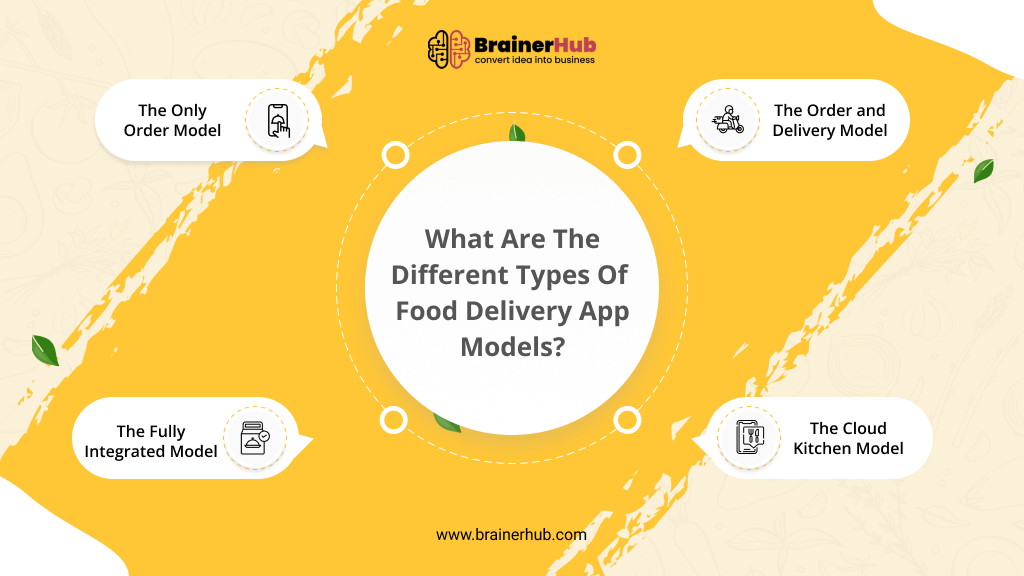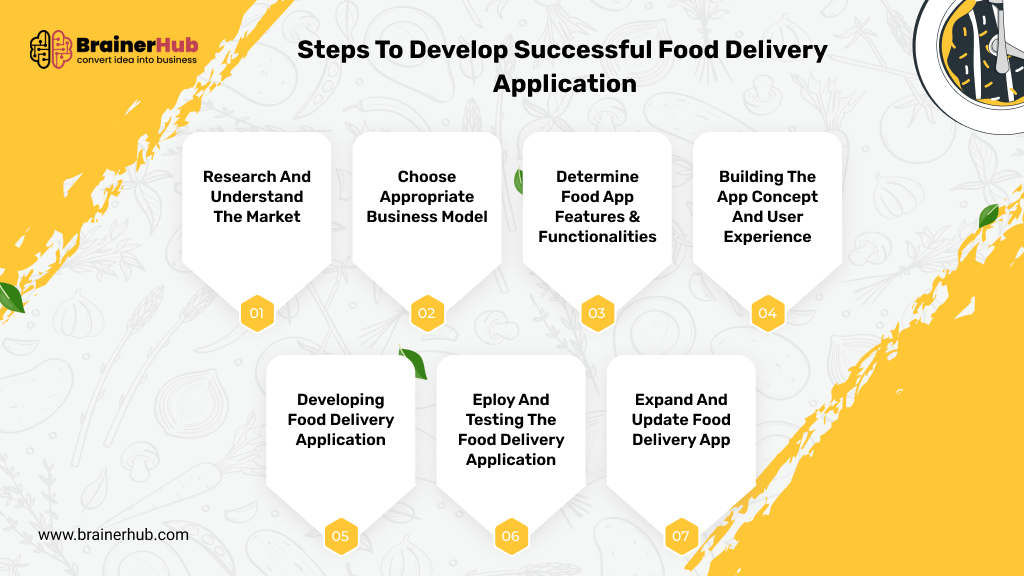The journey of food delivery app development begins with conceptualization and market research. Developers delve into understanding consumer preferences, market trends, and competitor analysis to identify unique value propositions and target demographics. This groundwork lays the foundation for creating a compelling and competitive product in the crowded food delivery landscape. From user-friendly interfaces for customers to robust order management systems for restaurants, every aspect of the app is meticulously designed to deliver a seamless experience. Features such as real-time order tracking, secure payment gateways, and personalized recommendations enhance user engagement and satisfaction.
What are the Different Types of Food Delivery App Models?
In this section, let’s discuss key business models that are currently popular in the niche of developing on-demand food delivery applications:
The Only Order Model
This food delivery business model is focused on providing platform dedicated solely to accepting and managing orders from customers, abstaining from direct involvement in the delivery itself. This model serves as an intermediary linking restaurants and customers. The delivery app business model is extremely scalable with no up-front expenses and improves the foundation of local restaurants with time.
The Order and Delivery Model
The platform accelerates the entire process of taking customer orders and delivering them right to the consumers’ doors. Therefore, to ensure that the consumers receive their meals in a timely and efficient manner, the model calls for coordination between the platform, restaurants, and delivery staff. The delivery service providers work with the food delivery platforms and order delivery fees are determined by the courier service providers.
The Fully Integrated Model
One of the business concepts for the food delivery app is the fully integrated approach. The platform handles all aspect of meal preparation and consumer delivery. For well-established restaurants with proper delivery infrastructure, this strategy is therefore perfect. This food delivery models allows you to have complete control over food quality and schedule the delivery time depending on the meal.
The Cloud Kitchen Model
The cloud restaurant concept is a great option for those who want to launch food delivery services from home. The customer’s order will be sent straight to the central kitchen for preparation. Next, the food will be delivered to the customer by the concerned delivery person. This platform allows to have full control over food quality and preparations. Cloud kitchen model usually requires less investment than other models as one could operate it from home.
The food delivery industry encompasses a diverse range of models, each with its own advantages and challenges. Whether you are hungry consumer or a budding entrepreneur, understanding these models can help you make informed decisions in this dynamic market. From aggregators to cloud kitchens, the future of food delivery promises to be both exciting and delicious.

Steps to Develop Successful Food Delivery Application
Developing on-demand food delivery apps can be made more successful by following a precise process. To make your food delivery app stand out in this fiercely competitive market, take these steps into consideration:
1. Research and Understand the Market
Development of food delivery apps necessitates a thorough grasp of the industry and the issues that both consumers and companies encounter. Finding the loopholes in the market that your app may address requires extensive research. Examine the strengths and shortcomings of your rivals to get ideas for developing advance features.
- Identify and resolve errors on food delivery application.
- Recognize competitors’ cost margin for their services and assess different pricing structures.
- Develop features that will provide customers an enhancing experience.
- Examine local laws pertaining to delivery services for food, licenses, permits, health, and safety.
- Understand user comments and reviews on current platforms to find area of improvement, development, features that customer find appealing and glitch issues.
2. Choose Appropriate Business Model
It is highly essential to choose the right business model for your food app delivery. Assess your available resources such as your delivery fleet, IT infrastructure, budget, and business relationship. For food delivery apps, businesses usually select from
- Order only model.
- Order and Delivery model.
- The fully integrated model.
All types of local and well-established restaurants can benefit from these models. The platform will let customers enjoy the meal of their preference within the comfort of their homes.
3. Determine Food App Features & Functionalities
Prior to developing your food delivery app, one should also decide the type of application they want to create. There are three primary app categories that contribute to the total ecosystem in the food delivery industry.
- Customer apps
- Restaurants apps
- Delivery staff apps
After evaluating the existing food app features, businesses should develop advance features and functionalities that will fill in gaps while providing users a delightful experience.
4. Building the App Concept and User Experience
The next stage after outlining the main functions and features of the app is creating app’s branding and visual identity suit the tastes of your target market by taking these factors into account. In order to facilitates rapid and simple order placement, the user experience should be clear and simple to traverse.
To make sure the app is aesthetically pleasing and simple to use, professionals will assist you. They will help to identify and take into the account the UI/UX designs for better approach. All screens have a uniform design that complements the app’s visual identity and branding.
5. Developing Food Delivery Application
This entails integrating all necessary features and programming functions for the app. Performance optimization is necessary to make sure the program loads quickly and operates efficiently. Developing an MVP is essential for smooth experience and introducing it to the market to start getting real users. Businesses could incorporate features and further refine app based on their feedback to improve user acceptability as well as experience.
6. Deploy and Testing the Food Delivery Application
Routine testing on the app is being created in order to find and fix any flaws or difficulties. To make sure the software is used by many consumers, testing ought to be conducted across a range of hardware and operating systems. To get input on the functionality and user experience of the app, one needs to conduct user testing.
7. Expand and Update Food Delivery App
To determine areas that could use improvement and potential new features, you should routinely gather input from your customers. Regular updates will help to address issues and enhance application functions. Further, data-driven growth marketing techniques will assist with promoting the app better, attract new users and keep a hold on existing ones.
Remember, the key to a thriving food delivery app lies in delivering exceptional user experiences, building trust with both customers and restaurant partners, and adapting to evolving consumer preferences.

What Is the Cost of Developing an App for Food Delivery?
Generally, food delivery app with necessary functionalities can range between $20,000 to $300,000 depending on the upgrades. Features like loyalty programs, in-app chat assistance, real-time order tracking, and restaurant management systems can have regular updates or versions. It is important to remember that these are only estimates, and the actual cost may vary depending on your unique needs and food delivery app development you choose to collaborate with.
Let’s discuss key factors that are considered for food development application pricing:
- Food Delivery App Design: The pricing depends on complexity of UI/UX designs. In the long run, an app can reap numerous concrete benefits from a smooth UI/UX experience.
- Project Scope: One may have accurate cost estimate to develop a food delivery app if only they have clear understanding of the project’s parameters and intricacy of the business logic.
- Developer Cost: Hiring professionals from global platform may have an impact on development costs.
- Payment portals: Adding several payment channels, such as credit/debit cards, PayPal, and Amazon Pay, is crucial for online food delivery app development hence it can affect the overall budget.
Future Scope of Food Delivery App Development:
The future of food delivery app development promises exciting advancements, drive by technological innovation and evolving consumer preferences. With the integration of artificial intelligence, machine learning, and data analytics, personalized user experiences will take center stage. The rise of smart kitchens and IoT connectivity will enhance order accuracy and streamline the entire delivery process. Real-time tracking, drone deliveries, and autonomous vehicles are on the horizon, ensuring quicker and more efficient order fulfilment.
Moreover, the future of mobile food delivery app development is poised for a transformative journey, marked by innovative technologies, enhanced user experiences, and a commitment to sustainability. As the industry continues to evolve, staying at the forefront of these trends will be essential for developers and businesses looking to thrive in the dynamic landscape of food delivery services.

Concluding Views on Food Delivery Application Development Process:
To conclude, the development of food delivery app is a multifaceted journey that demands meticulous planning, innovation, and dedication. By prioritizing user experience, embracing technology, and maintaining a commitment to excellence, developers can create a successful and sustainable platform that delights users as well as revolutionizes the way customers experience food delivery. From grasping the significant trends within the industry to exploring diverse avenues for generating revenue, entrepreneurs must carefully weigh their options before commencing the development process.
Are you planning to develop food delivery application?
Partner with BrainerHub Solutions – A renowned Mobile app development company. Reach out to our team for assistance!
FAQs
To create a successful food delivery app that will improve user experience, crucial elements such as:
- User profiles and registration
- Order tracking in real time
- Secure payment gateways
- Filters and search
- Reviews and ratings
- Discounts and promotions
- Across many platforms
- Rewards and recommendations
- Notifications
- Support for multiple languages
- Geolocation tools
- Integration of social media
- Chatbot for customer service
- Inaccessible offline
- Reporting and analytics
The food delivery application development time depends on the complexity, features and availability of resources. Building a moderately complex on-demand app might take, on average six to twelve months. If working on tight-deadline, cross-platform app development is a viable option.
To begin with, food delivery apps are quite popular and undoubtedly brings more money to the business. However, it is important to conduct complete market research, understand your rivals, analyse the existing food delivery apps to fill in the gaps. You must have something to stand out from the crowd!
Creating food delivery app has many advantages like facilitating simple online orders that will help to enable companies to reach a wider audience, extend their services beyond physical locations, and offer convenience to clients. The platform can also track orders in real-time, make personalized recommendations, and expedite the ordering process that contributes towards higher income and operational efficiency.

